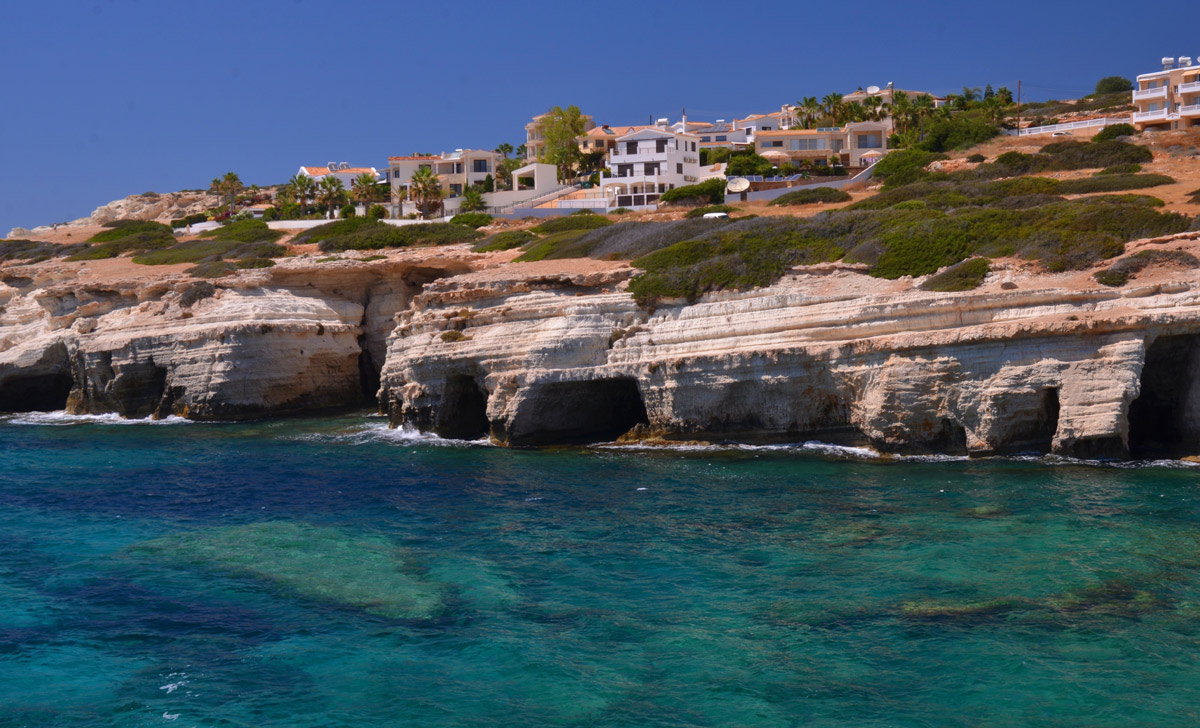Part 1 – Travel Essentials
Overview
Cyprus is a crab shaped island, which is only 40 miles from Turkey, 65 miles from Syria and 200 miles from Egypt. Cyprus is 3,500 square miles (bigger than Delaware, smaller than Connecticut) with a 400-miles long coastline. Being an Mediterranean island, it is not surprising that beaches are its main attraction. There are two large mountain ranges, Troodos and Kyrenia, which have a cooler climate, hiking opportunities, monasteries, churches and forts worth visiting. Population data is stale, but Cyprus has approximately 1.1 million people; clustered next to the shoreline.
The more than three-million visitors are mainly from Israel, Lebanon, United Kingdom (around a third), Greece, Russia (a rapidly growing amount) and other European countries. The country is a marriage destination, because of its sunny climate, tourist infrastructure and non-religious requirements. The latter is the main reason for Israelis (avoid required Orthodox Jewish ceremony) and Lebanese (no mixed religious weddings allowed) to have many weddings in Cyprus.
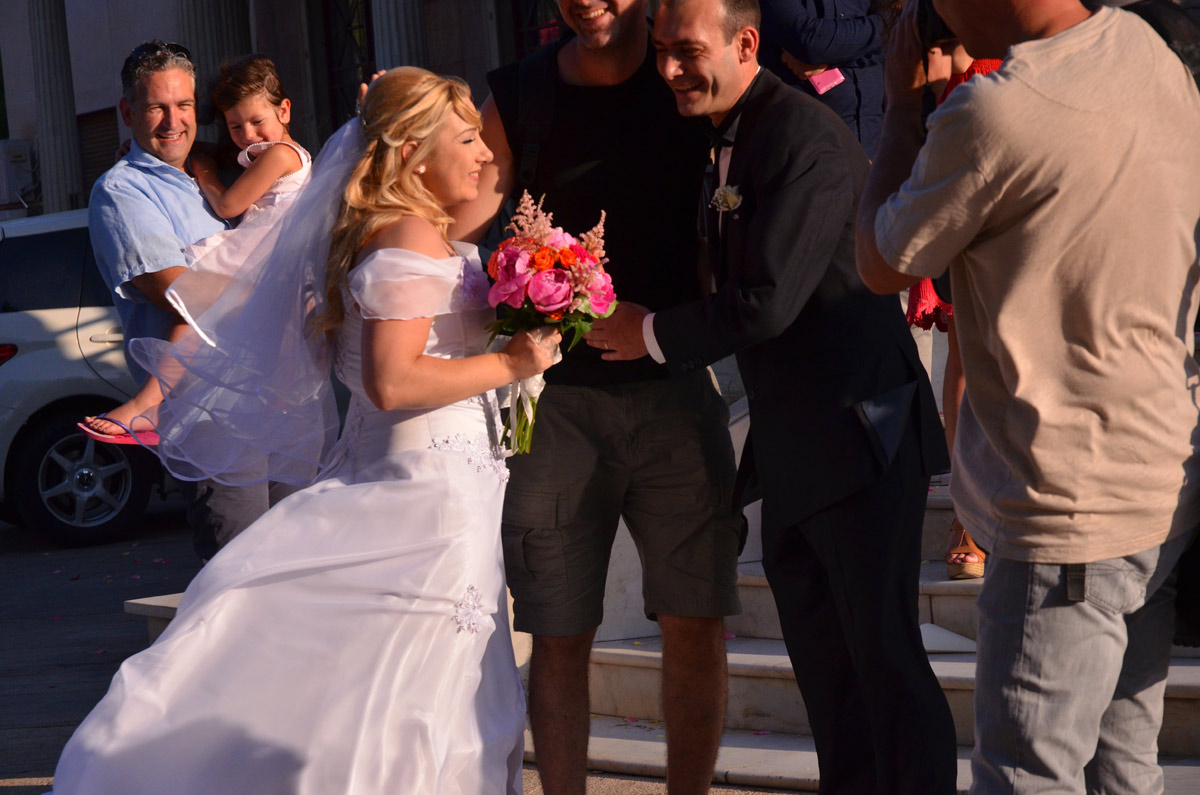
Cyprus has a long and complex history culminating into a divided island, since 1974, between the Greek south and the Turkish north. The Greek part is a member of the European Union and uses the euro, while the Turkish is part of the EU and uses the Turkish Lira. Since 1983, the Turkish part has called itself the Turkish Republic of Northern Cyprus. It is not recognized by the international community, except for Turkey which has 30,000 troops there. It was remarkable and controversial that the EU admitted only part of a country.
The Greek part is about 60% of the island and 80% of the population (including non-ethnic Greeks). The Turkish area is 37% of the country and about 20% of the population. Before the division, both communities lived throughout the island, but now are situated in their respective sections. There are two military bases under British sovereignty, which comprise the remaining 3% of the island. While this is complicated enough, the United Nations-controlled Green Line buffer-zone overlays about 4% of the island. So, the “divided island” moniker is well deserved. When talking about the country, it is necessary to be clear if you mean one of the sides or the whole island.
There was a UN-sponsored referendum in 2004, which the Turkish side approved by 65%, but rejected by 76% on the Greek side; mainly because they felt there were insufficient protections against Turkish military incursion. There are still efforts on both sides to unite the island, but there is little progress as it is now relatively easy to cross the Green Line at five vehicular and two pedestrian crossing points.
In Greek mythology, Aphrodite was born in sea foam and drifted ashore to Cyprus in a seashell (the basis for the famous Botticelli “Birth of Venus” painting. Venus is her Latin name). Greek settlements on Cyprus started 3,500 years ago. After World War I, the British took control of Cyprus from the Ottoman Empire. Cyprus became an independent country in 1960.
As an offshoot of centuries-old tensions between Greece and Turkey, there were continual disputes between the two ethnic groups. Since the creation of modern Greece in 1830, there has been an enosis (Greek for union) movement to incorporate Greek-speaking regions outside of Greece into Greece. The first president of Cyprus, archbishop Makarios III (who captured the imagination of the world because of his beard, black robe and black, stiff, cylindrical head-covering with a long black veil in the back) was supportive of enosis before independence and open-minded afterwards. However, he was not a hardliner for reunification, which sparked an internal coup supported by the Greek government’s military junta. The Turkish government responded five days later with an invasion of Cyprus, eventually occupying its current area. Afterwards, around 150,000 Greek Cypriots were expelled from the Turkish occupied part (where they were 80% of the population) and went to the Greek side. A year later, about 60,000 Turkish Cypriots, amounting to half the Turkish Cypriot population, were expelled from the Greek side to the Turkish part.
Many people avoid the stuffy history section of travel guides. In the case of Cyprus, unless you are only tanning and swimming on the beach, you need some awareness of the history to understand the country. Sometimes you feel you are in two countries, other times it’s one. In some ways, it makes the travel more interesting, but it is sad to see another example of the pernicious effect of ethnic conflict. There are now renewed talks by the two sides on unification. Odds are they will go nowhere fast, but it is a positive sign. My experiences with people brought me to believe that they could all live together again, just as the island has been a melting pot for millennia.
My wife, Khadija, and I traveled there (in June 2017) to visit Roger, a long-time friend of ours. He was our travel guide and drove us around the many different parts of the country. We found it fascinating for its varied topography, Mediterranean cuisine, easy-to-speak-with people, historical buildings, ruins, religious art and political realities.
Language
While Greek and Turkish are the daily languages in the country, English is widely spoken (especially in the hospitality industry).
Visa Requirements
Most tourists, except Turks enter on the Greek side of the country. Their EU membership allows the citizens of over 50 countries to enter without a visa for a stay of up to 90 days, provided they are bona fide visitors. The list includes the US, EU countries, Canada, Australia, New Zealand, Israel and some Latin American countries. Interestingly it does not include Russia, now the second biggest country which tourist are from.
As Northern Cyprus is not an internationally recognized state, the rules for entry are not easy to discern. From our experience, we had to show our passports to both sides every time we crossed the Green Line, in a car and on foot,
Currency
In the Greek speaking part, the euro is the currency (€1 = US$1.15 US$ for our trip). As a result, Cyprus is not a bargain destination (but not expensive either). In the Turkish part, the currency is Turkish Lira (YTL4 = 1 US$1 for our trip). The Turkish side is less expensive for travelers.
ATMs are widespread. It is best to only take the Turkish Lira you need, as you cannot exchange it back to US$ and € at a good rate; especially outside of the Turkish part.
Credit Cards
Credit cards are accepted in both parts of the country in the hotels, restaurants and tourist shops.
Air Travel
Our primary destination was Cyprus. We found that flights between Cyprus and the rest of Europe were relatively inexpensive. We used United frequent flyer miles to fly to Budapest (with Lufthansa) and return from Sofia (with Austrian Air). There was no more frequent flyer mileage used than if we flew round trip to either Budapest or Sofia, so this was a way to travel to two countries for the price (in mileage) of one.
We spent almost $700 on tickets (two from Budapest to Larnaca, two from Larnaca to Sofia), plus another $100 on baggage charges we were surprised about (check this carefully when buying tickets). We spent about a week each in Cyprus, Budapest and Bulgaria – three different experiences in one!
Transportation
There are buses between main cities and nearby rural villages in all of the country. We used the bus once, from Paphos to Larnaca, and it was efficient and only €33 for two for an hour and half drive (half hour break to switch buses). There are intracity buses with relatively low fares.
To see a wide section of the country, in a timely fashion, you’ll need to rent a car from either an international company (more expensive, easier to dispute a bill) or a local one. When entering the Turkish region, you need to buy additional car insurance for €25 for three days. Be sure your rental company allows passage there.
Lodging
We stayed in comfortable hotels, usually with breakfasts, for about €50 / night. Our friend, who lived there, made the reservation. He had stayed in all the places before and was able to get the best rate available. Someone from outside of the country might have to pay 10% to 20% more for comparable accommodations.
Cuisine
I love the Mediterranean diet with fruits, vegetables, whole grains, legumes, olive oil and emphasis on fish and poultry. There are slight differences between Turkish and Greek food, but nothing that stood out for us.
Internet and Phone
Wi-Fi is available in all the hotels we stay in. We used a roaming plan from our ATT&T Wireless service in the US. It cost $60 for free texting (for some reason, did not always work), phone calls for $0.50/minute and 300 megabits of data (which was enough, as we used Wi-Fi extensively). We may have been able to save money getting a SIM card in each country, but it did not seem worth the hassle. Of course, you can always use Skype, Google Voice or other apps from your computer to make calls, if you have internet access.
Safety
The country is safe throughout the island. However, there is a party scene in the beach communities. You should be careful when staying out very late and drinking.
Cyprus has a high rate of civilian gun ownership. It is best to avoid arguments and fights with locals in any country. Here there is a higher chance if the local person is armed.
As tensions are currently low between the Greek and Turkish section, so it’s easy to dismiss the UN Peacekeepers as window dressing. However, do not under any circumstances attempt to enter the U.N. buffer zone at any place other than a designated crossing point. This area is mined and militarized. Also, keep well away from all military installations in both sections, including the British bases.
Travel Guide
I usually use the Rough Guide, but I found a 2001 AAA Cyprus guide in a used book store in Greenwich Village for $5. Normally I would not get such a dated guide, but since I was travelling with a local it didn’t seem as important. In the guide, most tourist attractions are the same, but there are some new ones or expansion of old ones in the last 16 years that are not included.
Orientation
Most people fly into Larnaca, then proceed to their destinations. Except for Turks, few fly to the Turkish section. Many places have two or three names (English, Greek and Turkish), which can be confusing. For example, Nicosia is English, Lefkosia in Greek and Lefkoşa in Turkish. While road signs for major roads are partly in English, local signs may be in the Greek or Turkish (Latin with extra letters). It can be particularly challenging finding the crossing points between the Greek and Turkish sections, as there are no road signs for them. When going to the Turkish section, carefully remember your roads and landmarks, as it easy to get lost when returning.
Part 2 – Discovering Cyprus
Larnaca
We flew into Larnaca and emerged from baggage claim around midnight. Roger picked us up and went to Les Palmiers Hotel where we booked a small two-bedroom apartment with a balcony overlooking the beach for one night for €110. Larnaca is home of most of the industries of the island with an important port and oil refinery. For tourist, it is a seaside resort. There are some churches, mosques and museums which are worth visiting for no more than a day, but our schedule did not permit it.

The next morning, after coffee, we drove north to Nicosia. On the way, we passed the Larnaca Salt Lake. It is almost 1.5 square miles and the water level varies throughout the year. It is an important for waterfowl, but few were there when we passed.

Nicosia
We rolled into Nicosia in the early afternoon. The ride is only a half hour without traffic, but by time we found our hotel, parked and unloaded it was two hours later. We stayed at Kipros Accommodations, a narrow hotel filled with charming antiques (e.g. old sewing machine), for €40 / room for one night. We then walked around the old town, seeing a few weddings and browsing in a few shops (come in and have tea).
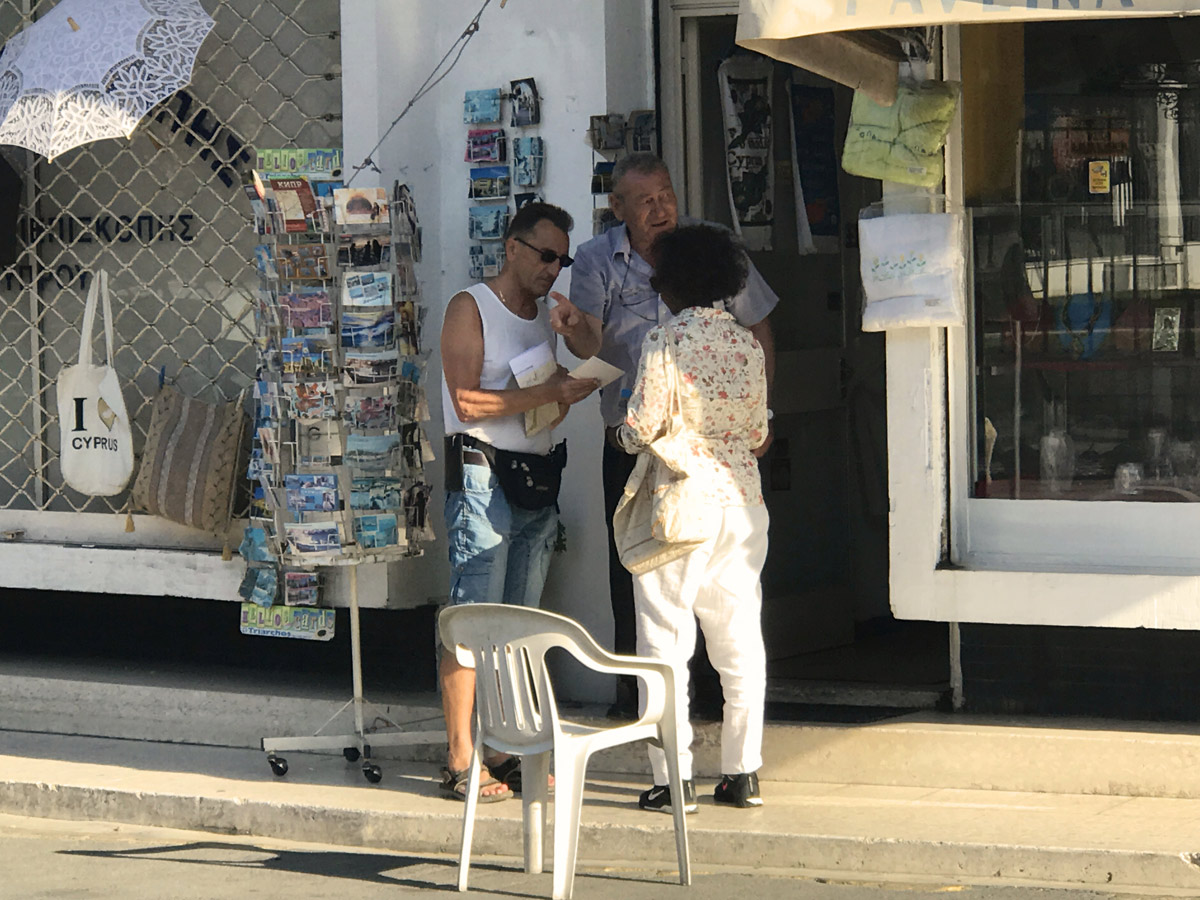
We walked by the Archbishopric, a small, understated building with a dazzling interior. It was closed (for what else, a wedding), but we got a glimpse of interior when someone opened the door. We could have gone into Cyprus Archaeological Museum, but it closed at 4pm. When I return, I will go there to see the Cypriot statues I have admired in the Metropolitan Museum of Art with their closed-lipped smiles, almost smirks. That night we ate a wonderful traditional meal outside at Piazza Tavern (2-4 Praxippos st.) for three with many appetizers, glasses of wine, coffee and dessert. The owner provided personal table service and a young lady with a guitar singing Greek folk songs. We paid €106.
The next day we walked over the Green Line through the Ledra Street checkpoint, showing our passports to each side, while a few blue-helmeted, UN troops were casually standing. We peeked into a large mosque and went to the Central Market with stalls selling food, books, furniture and other items. Most were closed, as it was Saturday.

We then went to Buyuk Han, originally built in 1572 by the Ottomans, it has a large courtyard with art galleries in the perimeter building. While having coffee there, there was a flutist and guitarist playing mainly western music, including a killer version of Santana’s Black Magic Woman. We then had to head back and check out.

Turkish Republic of Northern Cyprus
We drove through the Agios Dometios crossing point to the north coast of the Turkish section. We soon saw enormous flags of Turkey and Turkish Cyprus drawn on the side of a mountain.

St Hilarion Castle
Our first stop was the St. Hilarion castle. The ruins of this huge castle straddle a rocky crag in the Kyrenia Mountains. The entrance fee was YTL 9 / person (€2.20) and it was a moderately strenuous hike to the top, but most people can make it.
The castle was named after a fourth-century hermit, who lived in a monastery at this location. Around the eight-century, the Byzantines converted the monastery to a castle and The Lusignans (a French noble family) expanded it in the thirteenth century. When the Venetians controlled the area in the late fifteenth-century, they let it fall into disrepair. Some of the most interesting parts are the now-roofless church, the ridge-walk to the Western Tower and the many magnificent views.

Girne
We stayed two nights in the Dome Hotel for €170 for two rooms. It included a large pool and a vast buffet breakfast with ten different types of olives. Girne (Kyrenia in Greek) is built around a harbor with cafes and restaurants, under the shadow of the Kyrenia Mountains. At the end of the harbor is a castle with seemingly impenetrable walls and used by the Byzantines, Crusaders, Venetians, Ottomans, and British.
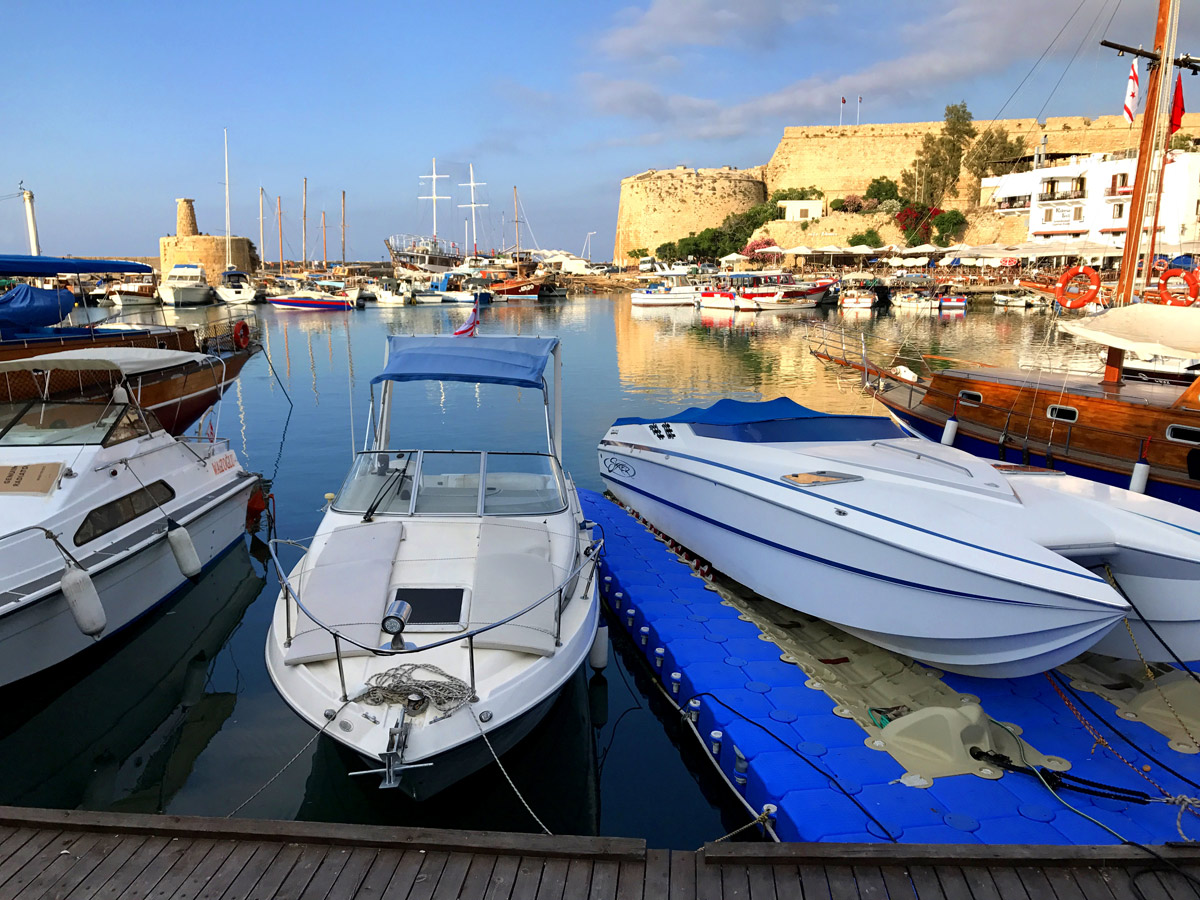
One night, there was a band (guitar, bass, drums, sax, trumpet, vocals) doing good covers of mostly American sixties-music. It was amusing though, when they were playing “Venus” by the Shocking Blue, the singer sang “Well I am your We-nus, I’m your fire at your desire”.
We noticed young Africans working in the restaurants and cafes. After speaking with them, we found that the Turkish part has sponsored hundreds of Zimbabwe to attend college here.

Bellapais Abbey
Bellapais (Beautiful Peace) Abbey was built eight hundred years ago, in a Gothic architectural style, on a stone cliff over city of Kyrenia.

The site has a museum and the refectory is used for concerts and lectures. While we were there, a young lady was practicing on the piano
The entrance fee was YTL 9 / person (€2.20). A highlight for us was eating dinner in the adjacent restaurant and watching the progression of the dusk and eventual sunset. For three, the meal in this relaxing venue was YTL 230 (€55).
The next day we returned to the Greek part. In the parts of the North we visited, it was plainly inhabited by Turks, but it did not feel the same as visiting Turkey. Besides mosques, the main tourist attractions were Greek or European. The hospitality industry is similar to the Greek section. My hope is that the island will relatively soon unite and perpetuate its multicultural mosaic.
Troodos Mountains
We spent the next two days in the Troodos Mountains. The highest point is Mt. Olympus (don’t confuse with the one in Greece) which has an elevation of almost 6,500 feet. The sizable mountains are covered with pine, eucalyptus and cedar trees and many endemic plants. The mountains are the home of the national animal, the Cyprus mouflon (Ovis orientalis), which are wild sheep found only here, but infrequently seen. The population increases dramatically in the summer. We met a medical doctor, trained in the United States, in the village of Pedoulas. He lived in Nicosia, but came here every week to see patients and he mentioned the population during the summer is 2,000; but only two hundred in the winter.
We stayed one night in the Themis House in the village of Lemithos. The hotel had good views, ten comfortable rooms, with excellent Wi-Fi and a small pool which I wondered if anyone used. We paid €96 for two rooms.
Kykkos Monastery
We spent two hours wandering around the rooms, passageways and courtyard of Kykkos Monastery. It is the most famous one in Cyrus and started about 1,000 years ago. While the current buildings are relatively modern, it has reputedly the most lavish chapel in the country (totally believable, but no photography allowed). There is no admission to the monastery, but it is €5 for the museum which has an extensive collection of icons and artifacts across the centuries. The highlights are the wall pintings and mosaics:


We drove a few minutes up the hill, passed the monastery, to Throni Hill, where the country’s first president Archbishop Makarios is entombed (there is a huge statue of him). The views are quite good. Makarios served as a novice in the Kykkos Monastery as a teenager.

Byzantine Churches
In the Troodos Mountains, there are ten Byzantine churches (three hundred to thousand years old). UNESCO declared them collectively as a World Heritage Site. On the map they look close together, but because of the mountains it would take at least two full days to see them all. We managed to see three and for my taste, this was extremely interesting. Left on my own, I would have gone to all ten. It was hard to believe that two of the three were small buildings, left unguarded with priceless frescos. I had to use a tripod to photograph the low-light interior.
The Church of the Archangel Michael in Pedoulas is a stone, asymmetrical building with the right-front roof much longer than the left. It has a single aisle with a semi-circular apse. It is not much bigger than some suburban living rooms. The interior frescos are from the Old and New Testaments. This church unusually has the signatures of the artists. As you would expect, it has an awesome Archangel Michael with an extremely serious expression, wonderfully detailed wings and sword in hand. In one fresco, the priest who funded the church, is depicted with his wife and two daughters offering a model of the church to Christ. The apse has the Holy Virgin between the archangels Michael and Gabriel.
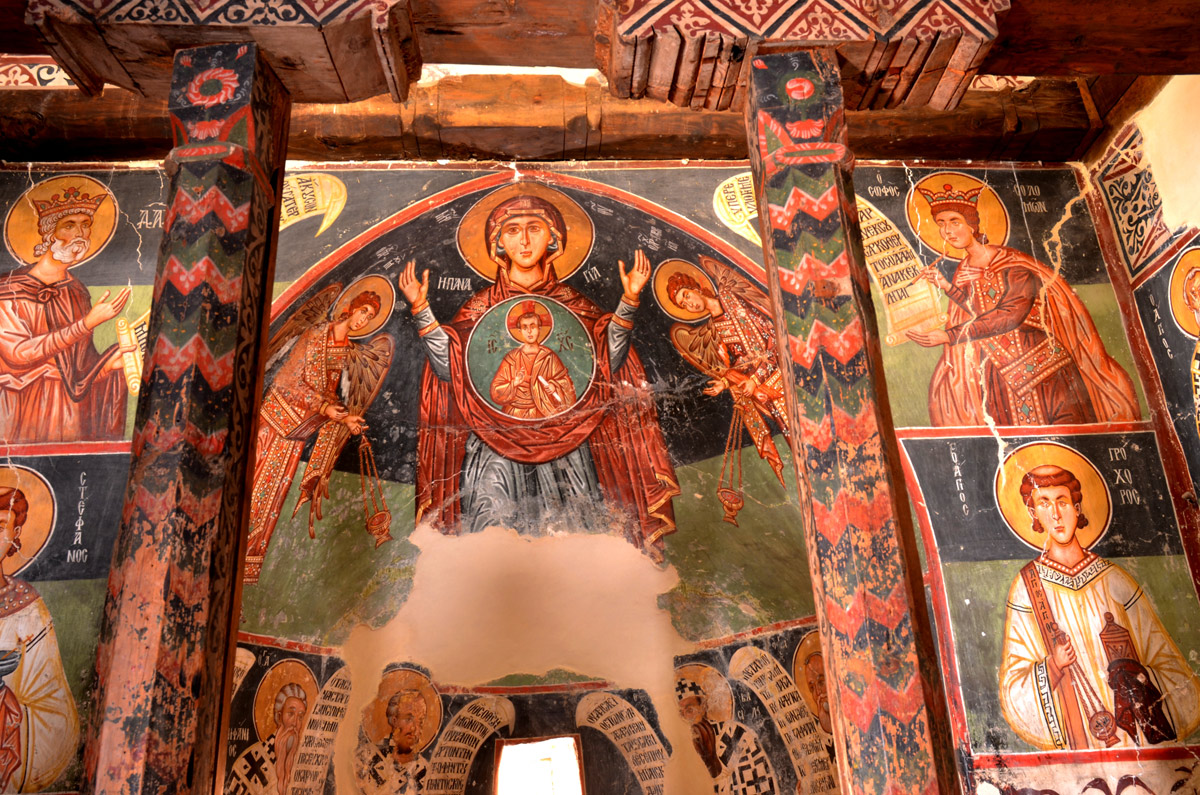
The Church of the Holy Virgin in Moutoullas is a small, timber-roofed building on a rocky hill above the village. It has a single aisle with an L-shaped closed portico on two sides. We could not open the front door, but entered through the side door. This is the oldest (thirteenth-century) church in Cyprus with dated wall-painted frescos. Note the partially remaining fresco of Jesus with a cross-shaped halo, blessing with his right hand and holding the gospel in his right. The gospel transcription is “I am the door. If anyone enters by Me, he will be saved>”

The Monastery of Saint John Lampadistis sits on the bank of the Marathasa River, opposite of the steep-hilled village of Kalopanayiotis.

This is a functioning monastery with two separate two-story buildings facing the main church, which was built over the centuries with two main chapels – a “Greek” one and a “Latin” one. Each chapel has frescos which represent iconography and styles of their traditions. No photography was allowed in the church.
Troodos Mountains to Paphos
The drive from Kykkos Monastery to Paphos, on the coast, would be normally under two hours. If you are not familiar with road and make a few stops, it would take three to four hours.
Outside of Pano Panagia, birthplace of Archbishop Markarios, we stopped at an abandoned village that Roger had discovered a few years ago while bicycling.

Closer to Paphos, there are two monasteries close to each other, which are worth stopping if you have not reached your limit on religious buildings: The Agia Moni Monastery and the Chrysorogiatissa Monastery. We stopped at the latter for a few minutes for scenic views and found out it sells wine from its own vineyards.
Paphos
Our last two days were spent in Paphos, which is the European City of Culture for 2017. Even though the city government was awarded this designation several years ago, it was still engaged in major construction projects for this designation. The city’s economy is based on tourists using the beaches, eating fresh seafood, sitting on the harbor and visiting historical and archaeological sites. The first night we stayed in the Pyramos Hotel, near the harbor for €75 for two rooms. The next night we stayed in Rododafni Beach Apartments, about a ten-minute drive from the center of city and next to King Evelthon Hotel for €50.
The most outstanding archaeological site is the Mosaics of Paphos, which are some of the finest Roman mosaics in the world. They show both daily life from second to fourth-century and mythological scenes. Archaeologists discovered it in the 1960s. The area is scattered, some covered in modern buildings, but most out in the air. As this is the Mediterranean, it can be very hot, so take water, sun screen and protective clothing. The admission fee was €4.50 / person. Two of my favorites are:
The circular and intact mosaic of Theseus and the Minotaur.

The bearded man representing winter in the House of Dionysosl

In Paphos we ate at the Phapou Fish Restaurant, which was the best restaurant during our visit in the country. Roger had a large slice of octopus and I had a similar sized slice of squid. The menu indicated which fish was farmed and the restaurant owner would personally capture most of the fresh fish in the morning.
Peyia Sea Caves
A few miles west of the city o Paphos, are the sea caves of Peyia (also spelled Pegeia). They are also known as Kantarkastoi caves. These caves are located on bays and formed by thousands of years of erosion. Worth a drive to see. Best to go in the late afternoon or evening an hour or two before sunset.

Final Thoughts
Cyprus can be just a holiday on the beach or it can be a tour of the island, which we did. I recommend the Troodos Mountains (both sides of Nicosia), time in the Turkish part and at least a little time relaxing at a seaside resort. Somewhere in your trip, visit the monasteries, churches and museums of Cypriot art and you’ll never forget your experience in this beautiful country.

